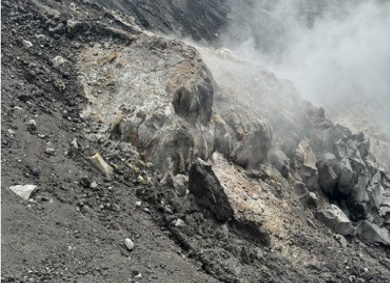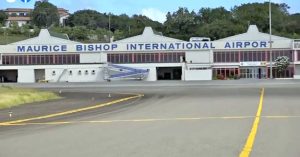Caption: Steam emitting from rocks inside the crater of La Soufriere on September 7, 2024
By Kenton X Chance
KINGSTOWN, St Vincent— A geologist with the Trinidad-based Seismic Research Centre (SRC) Tuesday said that the high temperatures detected at the La Soufriere volcano on Sunday are unusual when the volcano is not erupting.
“That’s why it’s sort of piqued our interest because… since 2021 we have not had any of this kind of signal coming out,” Professor Richard Robertson said on the state-owned NBC Radio.
Robertson, a Vincentian, is based at the St Augustine campus of the University of the West Indies’ (UWI) SRC and played a key role in monitoring the volcano after it began erupting effusively in December 2020.
On April 8, 2021, he forecast accurately that the volcano would erupt in less than 24 hours.
He said on Tuesday that given the unusual activity at the volcano, scientists are looking at it “even more closely and being more cautious”, adding that thermal spots are normal at volcanoes that are erupting or that in some state of unrest.
“Having this abnormally high temperature would not be usual at volcanoes that are in the state that Soufriere is supposed to be — in between eruptions,” he told radio listeners.
“And certainly, it was not normal for this particular volcano, because it’s the first time we have seen it since 2021, which is why the information went out at a very early stage that this is something that we have noted and that the public need to be cautious about it.”
On Monday, the National Emergency Management Organisation (NEMO) said that the NASA FIRMS hot spot detection system had on Sunday detected above-normal temperatures at the 4,000-foot volcano, the nation’s highest peak.
NEMO advised people to stay away from the volcano but pointed out that the alert level remains at green or normal, the lowest of the four-level scale.
“People shouldn’t now start getting overly concerned We have dealt with an eruption in the past and we know that it’s being monitored,” Robertson said, adding that the volcano monitoring mechanism has “picked up something very early, and we are saying let’s check it out a little bit more and make sure we know it’s one or the other before we have people walking about or … before we get to a different stage.
“… it’s not unusual at volcanos, but it was unusual at this one because it hadn’t happened in the last two years or three years.”
Speaking on the radio programme, NEMO Director, Michelle Forbes, said that members of the Soufriere monitoring team would climb the volcano later on Tuesday to collect gas samples.
Monitors are also hoping to get a clear view inside the crater, Forbes said, noting that the elevation and rain often affect visibility.
Forbes said the team had visited the volcano on Friday.
“They did not see anything visually unusual, but they collected the gas samples,” she said, adding that the samples are usually sent virtually to Montserrat for analysis.
She said the analysis began on Monday and NEMO was hoping to get some feedback later on Tuesday.
The Coast Guard had travelled up the west coast and collected gases for analysis on Monday, Forbes said.
“This is a daily activity for the unit. And we also check in on all of our equipment along the island,” Forbes said, noting that there are over 15 GPS and seismic stations across the island that monitor the volcano and more are being installed.
Robertson said that scientists are especially interested in finding out if the volcano’s sulphur dioxide output has increased.
“… the way in which magmas get rid of their gasses, you tend to find that sulphur dioxide is one of the gasses that you would often have enriched or high amounts of if you have a fresh new magma close to the surface,” he explained.
“So, we’d be looking particularly at whether or not the sulphur dioxide output, which is currently very low, or, in fact, negligible, almost you can’t detect it, because it’s such a small amount relative to the other gasses. We’d be looking to see if it’s increased.”
He noted that the gases would be analysed by Thomas Christopher, a resident scientist at the Montserrat Volcano Observatory, who is a specialist in this field.
“And so far, the measurements that he’s collected indicated that the sulphur dioxide might not have changed,” Robertson said.
“So, the signals are looking more positive in terms of this not being a restart of things, which is what we all don’t want to see at this point in time.”
So far, scientists have offered three possible explanations for the above-normal temperatures.
“Potential scenarios associated with the detection of the thermal anomaly include a sulphur fire in the crater, a small phreatic (steam) eruption that may have exposed hot underlying rocks, or the start of new extrusion of lava in the crater,” NEMO said in its statement on Monday.
“… today or tomorrow, we’ll conclude which direction it is,” Robertson said, adding “and that’s why I think the caution [has] gone out from NEMO that we would suggest people don’t go up to the crater.
“Certainly, don’t go into the crater, because whatever else, there’s hot material in there. And this, it probably is more exposed than it normally is,” said Robertson, who noted that monitors would be using drones to look into the volcano.
Robertson said the higher atmospheric conditions being experienced in St Vincent and the Grenadines, where temperatures have risen uncharacteristically high to the low 30° Celsius are more likely linked to climate change.
“The fact that clearly we have some changes going on in climate that is not necessarily going to affect how Soufriere itself has been behaving for the last million or so or more years, and will continue to behave,” he said.
He said scientists have informed the government previously that the volcano – which erupted in 1902, 1979 and 2021, clearly has “indicated that it’s moved from having activity that is very widely-spaced.
“… when I was a young boy, and first thought of going into this business, the thinking was that Soufriere’s eruptions were, it’s exclusive eruptions, at least were in the order of 100 years or so apart.
“Clearly, over the last since 1902, over the last century or two, it’s had more frequent events, but events have been small in size.”
Robertson said that while a 200-year period is too short to make “too much strong estimates, … based on that, it seems that we have activity more frequently, unusual things happening more frequently at Soufriere than we did before.
“That unusual thing could be hot spots like we might be seeing now. It could be more fumaroles; it could be explosive activity. It could be effusive activity. That’s the reality. So, the point is that once you live in St Vincent, and if you live here, you call this beautiful land your home, Soufriere and the activity of Soufriere is going to be something that we have to live with.

“And when I say live with, it means that it has to become something that we prepare for and deal with if and when it does rise to it, which is what we’re doing now by monitoring it, by telling people what’s happening and telling them to listen out and bear in mind that they have to take action, stay away from the volcano for a little bit or they may have to move, that kind of thing. We have to be prepared for that kind of thing in the future.”
La Soufriere displaced an estimated 20,000 people, about one-fifth of the population, when it erupted in April 2021. It also destroyed or damaged hundreds of homes and other buildings in the volcano red and orange zones and resulted in extensive damage to agriculture and forestry. (CMC)
![]()
















